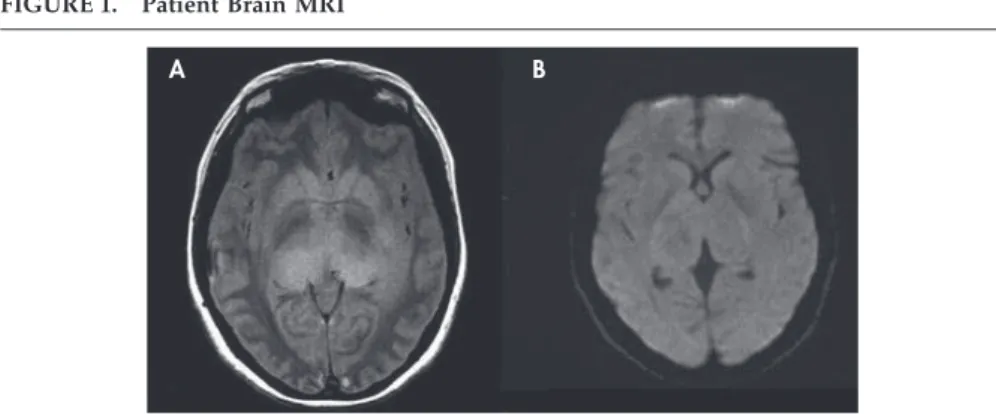Primary Bilateral Thalamic
Astrocytoma Presenting
With Head Tremor, Ataxia,
and Dementia
To the Editor:Primary bilateral
tha-lamic gliomas are exceedingly rare and usually present with behavioral and cognitive abnormalities, sparing motor and sensory functions.1Brain imaging reveals bilateral homoge-neous enlargement of thalamic nuclei, which appear hyperintense on T2-weighted imaging.1
Case Report
A 42-year-old woman was seen for 6-month progressive behavioral dis-turbances. At that time she started being unusually aggressive and impatient, complaining of headaches, aching pain in the right leg, and head tremor. The behavioral changes worsened slowly, and she grew inca-pable of doing things she previously did, such as cooking, cleaning the house, administering medicine to her mother, and caring for her 13-year-old daughter. Relatives reported that she walked with poor balance. When seen, she thought she was in 1970 and in another hospital and that the reason for the consultation was a bloody nipple discharge. Ocular movements were uncoordinated, and she had a rhythmic nodding head tremor, choreoathetoid movement of the right hand, and bilateral cerebel-lar signs. Muscle strength and sen-sory functions, as well as visual fields, were normal. Neuropsycho-logical assessment showed moderate to severe impairment of executive function, language, semantic and episodic memory, and visuospatial abilities. Noticeable was a severe
involvement of temporoparietal cor-tical functions, with Gerstmann and Balint syndromes.
Patient brain MRI (Figure 1, panels A and B) disclosed a bitha-lamic diffuse homogeneous lesion, hyperintense on T2 and iso-intense on T1-weighted images, without restricted diffusivity or gadolinium uptake. EEG showed an 8-Hz back-ground activity. Electromyography characterized the head tremor as rhythmic at 3 Hz. A stereotaxic biopsy was performed, with removal of tissue from the right thalamus.
Histological examination showed astrocytosis with minor nuclear anaplasia and inconspicuous cyto-plasm. A few normal large tha-lamic neurons were found. Spongi-form changes were absent, as were mitotic figures. Numerous GFAP-positive processes were present. The diagnosis was of astrocytoma, grade 2 (WHO). On an oncology consultation, only palliative care was proposed. The patient died 3 months later.
Discussion
As a complex integrating system, the thalami play a central role in
ner-vous system function. Pain and dys-esthesia can reflect ventral posterior nuclei involvement, since they receive temperature and pain affer-ents from the contralateral hemi-body.2A variety of movement disor-ders have been related to lesions affecting the ventral inferior or ven-tral intermediate nuclei, as well as the centromedianum and pulvinar, presumably because of their inter-connections with the basal ganglia.3
Cerebellar symptoms can result from dysfunction of the ventral anterior, ventral lateral, intralaminar, or retic-ular nuclei, which are functionally linked to the cerebellum.4The
thal-ami also participate in cortical func-tioning, by three major networks: temporoparietoccipital, connected with the pulvinar; prefrontal, mainly related with the dorsomedial nuclei; and limbic, which receives efferents from the anterior thalamic nuclei.4
Additionally, intralaminar nuclei have a central role in arousal and, with the dorsomedial nuclei, in attention.5We believe these known functions can explain all of our patient’s symptoms, even the most atypical and, to our knowledge, not previously described, as the head
FIGURE 1. Patient Brain MRI
A B
A. PD-weighted axial image shows a hyperintense infiltrative lesion involving both thalami, including the pulvinar; B. DWI reveals slight high signal in the enlarged bilateral thalami (without restricted diffusion)
LETTERS
J Neuropsychiatry Clin Neurosci 22:3, Summer 2010 http://neuro.psychiatryonline.org E7
tremor, the ataxia, and the combined Gerstmann and Balint syndromes.
A´lvaro Machado, M.D.
Neurology Department, Hospi-tal de Sa˜o Marcos, Braga, Por-tugal
Manuel Ribeiro, M.D.
Neuroradiology Department, Hospital de Sa˜o Marcos
Margarida Rodrigues, M.D. Carla Ferreira, M.D.
Neurology Department, Hospi-tal de Sa˜o Marcos
Rui Almeida, M.D.
Neurosurgery Department,
Hospital de Sa˜o Marcos
Isabel Santana, M.D., Ph.D.
Neurology Department, Hospi-tais da Universidade de Coim-bra, CoimCoim-bra, Portugal
Li´gia Castro, M.D. Stirling Carpenter, M.D.
Pathology Department, Hospi-tal de Sa˜o Joa˜o, Porto,
Portugal
References
1. Partlow GD, del Carpio-O’Donovan R, Melanson D, et al: Bilateral thalamic
glioma: review of eight cases with per-sonality change and mental deteriora-tion. AJNR Am J Neuroradiol 1992; 13:1225–1230
2. Afifi AK, Bergman RA: Functional Neu-roanatomy: Text and Atlas.New York, McGraw-Hill, 1998
3. Lee MS, Kim YD, Yang JW, et al: Clinical and anatomical factors associated with thalamic dyskinesias. J Neurol Sci 2001; 182:137–142
4. Perea-Bartolome´ MV, Ladera-Ferna´ndez V: El ta´lamo: aspectos neurofuncionales. Rev Neurol 2004; 38:687– 693
5. Steriade M, McCormick DA, Sejnowski TJ: Thalamocortical oscillations in the sleeping and aroused brain. Science 1993; 262:679 – 685
LETTERS
E8 http://neuro.psychiatryonline.org J Neuropsychiatry Clin Neurosci 22:3, Summer 2010
